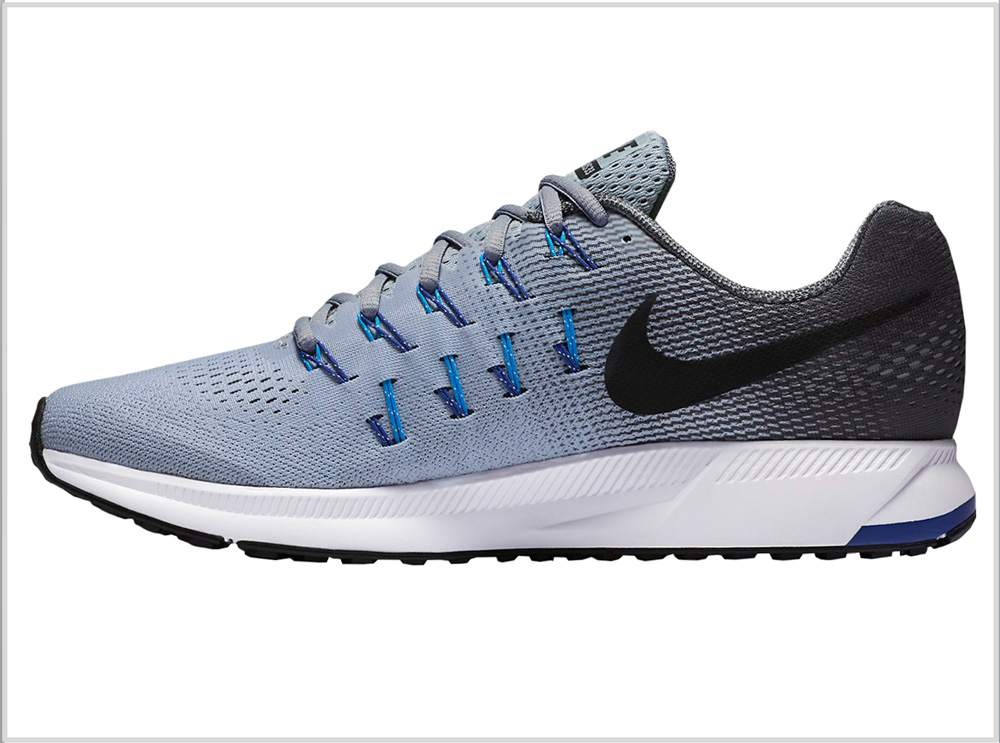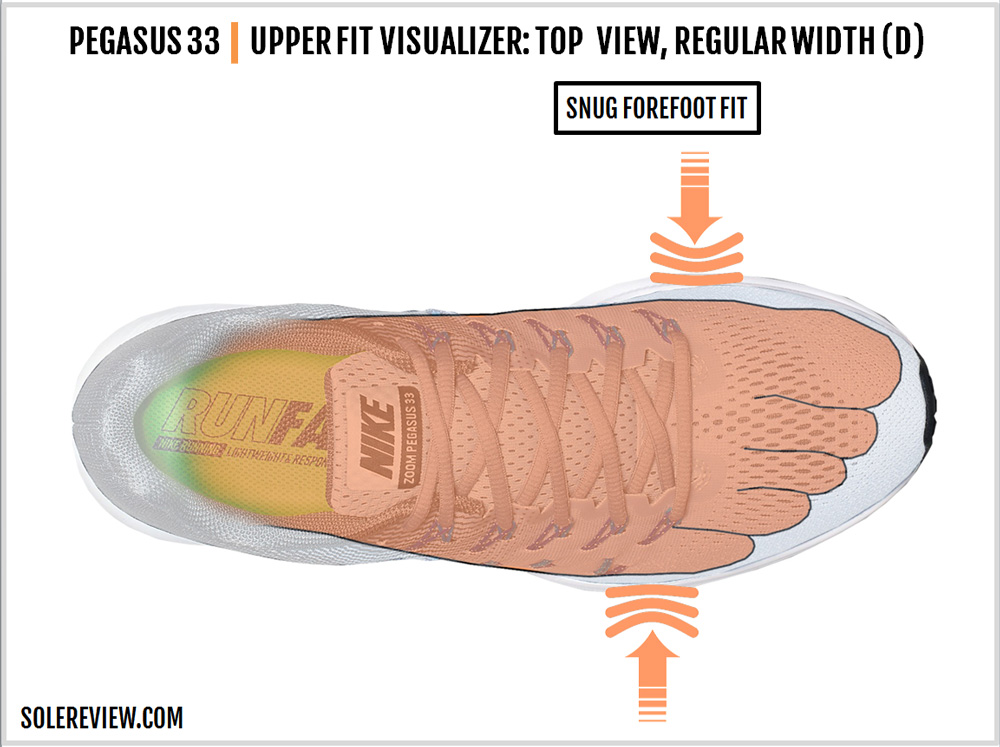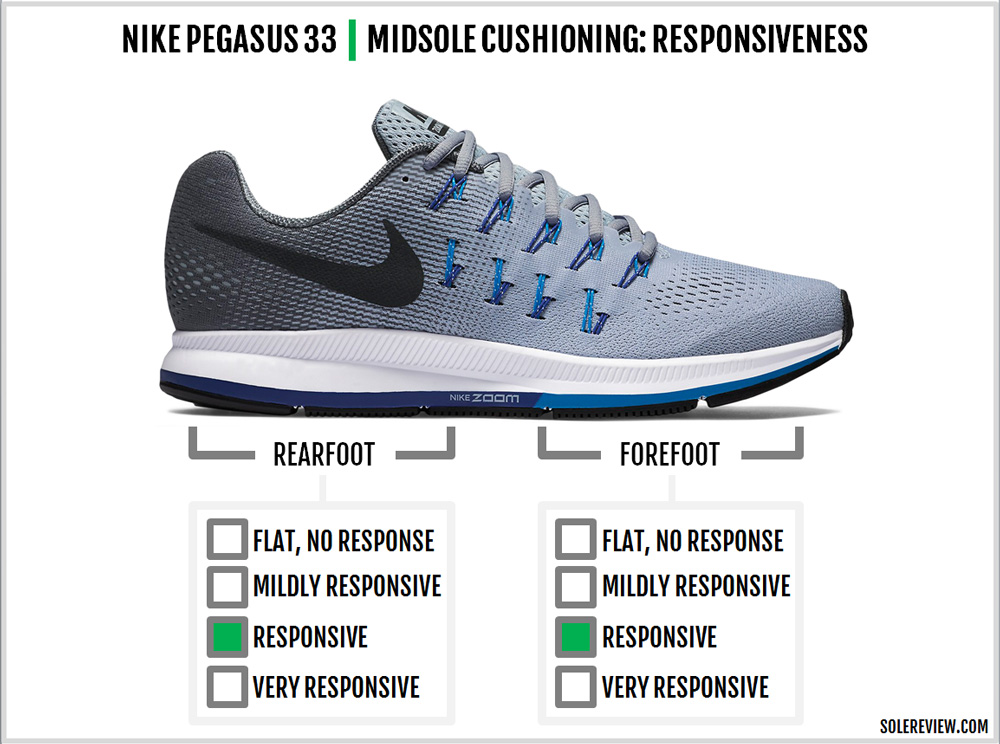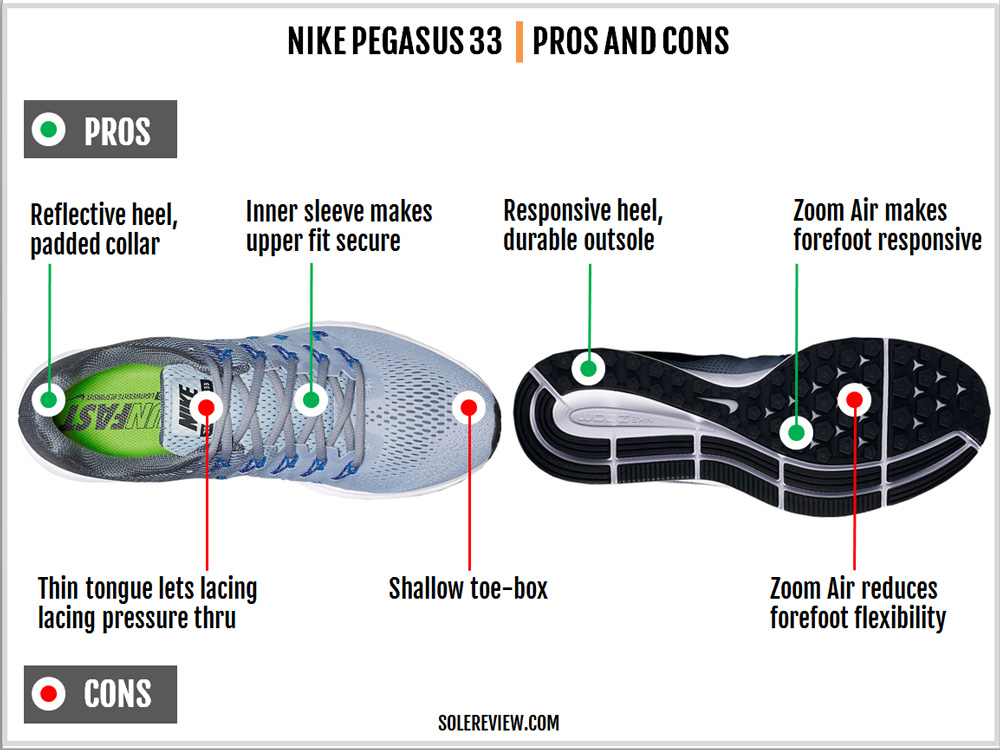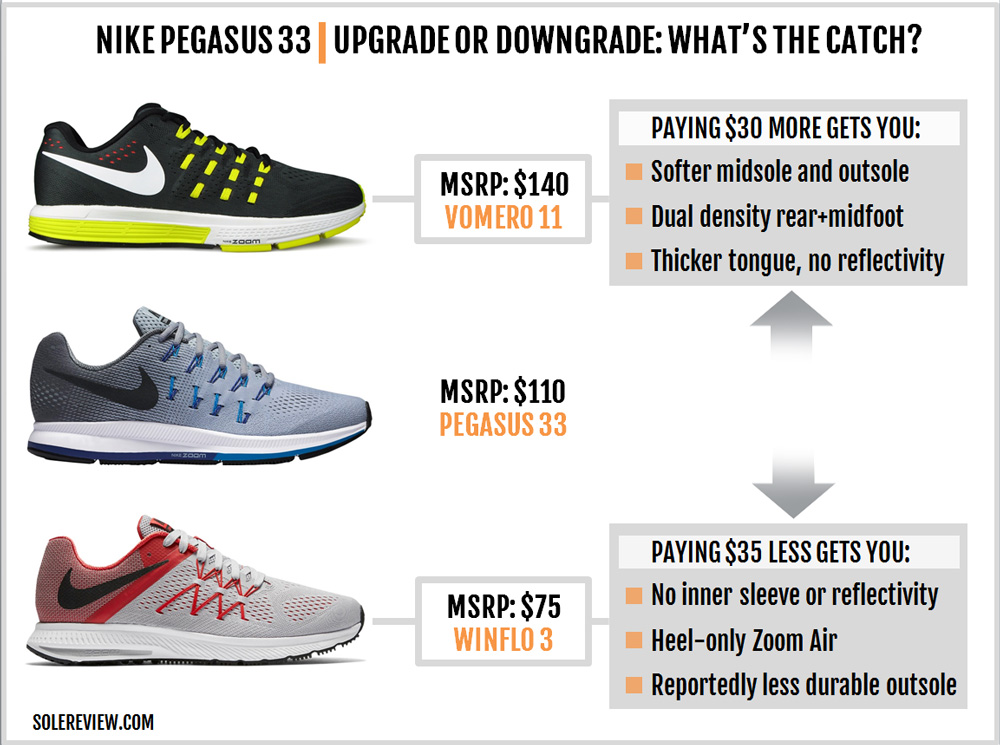INTRODUCTION:
There’s a good reason why the Nike Pegasus has been around for such a long time. It’s the Swiss Army Knife version of a shoe; be it medium paced runs or the occasional marathon, the Pegasus is good for almost any job you give it.
Along the years, there have been a few changes. Till recently, the Pegasus had a medium-soft ride with a roomy upper (Pegasus 29, 30). Then came the firmer Pegasus 31 with its pointy front-end. The Pegasus 32 introduced some minor tweaks while keeping most of the 31 intact.
The version #33, however, is a reflection of the times the new Pegasus lives in.
For a long time, shoes such as the Pegasus had the upper hand when pitched against other shoes. After all, Nike Air does work when put to proper use. A midsole cushioning tech like the Zoom Air is real, producing a responsive, spring-like effect which was historically difficult for foams to replicate.
But that was in the past.
Today, there are plenty of similarly priced shoes to choose from. Competing models such as the adidas Glide Boost make use of new advances in material science (Boost) to deliver a consistently cushioned and responsive ride, and brands like Saucony have followed suit with their Everun foam based line-up.
BASF’s Infinergy foam has become a great leveler, bringing previously unavailable properties to midsole foam. Frankly, if solereview had to choose between the Pegasus and the Glide Boost, we’d pick the Glide. Though, adidas seems to have shot themselves in the foot by swapping the extremely durable Continental rubber outsole with an Ultra Boost inspired sole geometry and material.
Needless to say, the venerable Pegasus is feeling the heat. And that’s reflected in the form of a major update over the Pegasus 31 and 32 – the Pegasus 33 now has heel and forefoot Zoom Air.
Yup.
DESIGN AND MATERIALS:
The Pegasus 33 is based on a visual template similar to the Pegasus 31 and 32. The upper has a sleek profile with a distinctive forward slope. Like the past two versions, an internal toe bumper is glued to the underside of an engineered mesh upper.
This construction approach keeps the Pegasus’s upper free of any external overlays except for the no-sew Swoosh logos on the back. There are internal layers, of course. Like the inner sleeve which is connected to the tongue and keeps the latter from sliding around. Or the heel lining with foam inside.
Lacing is hooked up to Flywire cords like it is on most Nike shoes nowadays. The Flywire placement has been updated, though. Instead of the in-your-face display of the Pegasus 32, the cords are now semi-concealed, snaking their way up through sections of the engineered mesh.
The lacing panel is reinforced with a transparent laminate to keep them from fraying – and we should mention that the Pegasus 33 has an additional lace-loop (seven instead of six) over the 32. Last year’s Pegasus was missing the eyelet needed for heel-lock lacing, and the Pegasus 33 corrects that oversight.
Night-time visibility (or the lack thereof) was an issue on the Pegasus 32. It didn’t make sense at all because the 31 had loads of shiny bits. This is another area where the 33 makes amends; the heel now features reflective inserts à la the Pegasus 31.
The midsole looks familiar. The lateral (outer) side has a prominent ridge which runs from the forefoot to the heel, and the medial side is a relatively solid piece of foam. Under the arch, the midsole edges flare out gradually.
These are minor cosmetic updates, but the biggest change is the one which you can’t see from the outside. The Pegasus 33 forefoot has a Zoom Air bag insert, much like the more expensive Vomero. At one point in Pegasus’s career a full-length Nike Air bag was standard fitment, so in a way, this is the Pegasus going back to its roots.
The outsole geometry is now a mix between the Pegasus 32 and the Zoom Elite 8. It borrows design cues from the previous Pegasus in the form of the heel-to-toe rubber coverage while melding the hexagonal lugs from the Elite 8.
Also, worth noting is that the outsole now has increased articulation. The side ‘crash rails’ strips are divided into five parts instead of the three from the Pegasus 32. This has an effect on the ride behavior – we’ll talk about it during the ride break-out.
The Pegasus’s outsole has always been an excellent performer in areas of grip and durability, and the 2016 design does not disappoint. The hard-wearing rubber used on the 31 and 32 shows up on the 33’s underside too, and making the grip even better is a design update. No, it isn’t about the hexagonal lugs.
If you look closely at the outer crash rail, you’ll notice that it has these rib-like structures. If you remember, a similar design was used on the Pegasus 30, and that is one of the reasons why the 30 performed so well on traction.
We don’t recall a version of the Nike Pegasus which has fared poorly on outsole durability. A long lasting outsole has always been a hallmark of this popular shoe model, and the Pegasus 33 certainly doesn’t lag in that department.
The median lifespan for the Pegasus 33 is 450 miles based on the data we have so far. Previously the Pegasus did not have forefoot Zoom Air, so the midsole foam was usually the first point of failure, losing its cushioning properties over time.
Since the forefoot now has Zoom, it extends the latter’s cushioning lifespan. So the likely point of failure will be either one of the following two. The outsole will gradually shred under high-wear areas such as the medial forefoot or outer heel, or one of the Flywire cords will eventually fail.
The Pegasus has a sturdy build quality, so it is unlikely that you’ll encounter sudden surprises of an unpleasant kind during short-term ownership.
UPPER FIT AND FEEL
If you’ve owned a pair of the Pegasus 31 or the 32, then the 33’s interiors will feel familiar. Much like the past two models, the 33’s toe-box is slightly shallow. This is noticeable if you’re switching from say, an adidas Glide Boost or the Brooks Ghost.
That said, we must clarify that Pegasus 33 shallow isn’t the same as Lunartempo shallow. It is just that the toe-box is shallow in relation to many other mid-weight neutrals.
The tongue is padded but not luxuriously so. As a result, the top-down pressure isn’t as filtered as you’d like it to be. One of the reasons why tongues in Nike shoes feel a tad spartan of late isn’t because of the lack of foam fill. It is rather the mesh material used to construct the tongue.
In shoes such as the Nike Pegasus 30, the upper mesh was of a spacer kind. Those meshes had inherent padding built into them. In contrast, the new fangled engineered meshes have a flat structure and lack any sponge-like properties.
The heel uses a soft hand-feel fabric with generous padding fills inside, leaving nothing to complain about the heel fit. And if you needed extra grip, then the heel-lock eyelet is now back on popular demand.
The Pegasus comes in four widths, which is an improvement over the time when even a lowly 2-E was a luxury. Today, Nike is at par with New Balance when it comes to the availability of widths in certain models.
In standard D width, the forefoot fit is in the sweet spot with no issues. As a matter of fact, ever since Nike adopted the engineered mesh-sleeve combo, localized fit pressure has become a thing of the past. Otherwise, the presence of layers on the outside or seams inside usually resulted in isolated pressure hot spots.
RIDE QUALITY AND BEHAVIOR
The Nike Pegasus has a ride what could be called as medium soft. While the blown foam insole adds the first layer of softness, the front and rear Zoom bags counter-balances the ride with a degree of firmness.
It is softer in the back than it is in the front, owing to a few design differences. There’s more foam under the rearfoot, and at the same time, there is an exposed area of foam under the heel. This produces a trampolining effect which makes the heel softer.
In comparison, the Pegasus 33’s forefoot midsole foam stack is thinner, and there’s a Zoom bag inside. And unlike the rearfoot, the forefoot has full outsole coverage. So the front is firmer than the rear, and more so than the Pegasus 31 or 32. While the Zoom bag has its benefits, it makes the forefoot stiffer than before.
And what if you don’t like the new forefoot feel? Head over to the summary section for alternatives.
Needless to say, the addition of forefoot Zoom brings new things to the table this year. While the past two Pegasus models had a comfortable yet flat riding forefoot, the Pegasus 33’s forefoot has increased responsiveness.
Like most Zoom Air bag equipped shoes, the responsive behavior is more pronounced with increased speed – it’s not something one would experience right away during an in-store fit trial.
So forefoot strikers, rejoice. If you liked the forefoot ride of shoes such as the Zoom Elite 8 or the Vomero 11, then consider the Pegasus 33 as middle ground between the two. There’s softness packed within the foam insole and midsole, while Zoom makes it responsive on impact.
The Pegasus has acceptable levels of stability. The forefoot is slightly more supportive than the rear, where there’s a slight bias or lean towards the lateral/outer side. This is due to how the midsole is designed; the lateral side has a deep groove running over the sidewall length while the medial (arch) side is devoid of such features.
This is standard footwear design meant to ease rearfoot landings, and this lean is seen in multiple variations across the industry. The midsole (and the heel edge outsole) is also flared aggressively towards the lateral/outer side. This part is designed thus to deliver gradual transitions.
Transitions happen slightly faster on the Pegasus 33 vs. the 32, and that’s because of a stiffer forefoot. This behavior is similar to the Zoom Elite 8, where a firm front-end helped in quicker toe-offs.
PROS AND CONS
There aren’t any deal breakers on the Pegasus 33. The upper fits well owing to the inner sleeve and one-piece mesh; the ride is great, and the outsole is durable. At the same time, there are certain characteristics of the shoe one should know about.
Putting Zoom Air inside the forefoot makes that part of the shoe stiffer. So the trade-off for increased responsiveness is the flexibility and natural forefoot feel of the earlier Pegasus models.
The other two areas concern the upper fit. The toe-box might feel a bit shallow if you’re used to some of other brands, and the tongue feels sparsely padded which lets some of the lacing pressure through.
RECOMMENDED ROTATION
Hey, one shoe life is boring. What if you wanted to make your runs more fun with multiple shoes? We’ve put together a recommended list of other shoes you should look at – within the same brand and outside.
If you’re looking at Nike, then we recommend the Nike Lunarepic for a plusher ride and the Nike Zoom Streak 6 as a lightweight option for those fast runs. And why not the Vomero instead of Lunarepic, you might ask?
The newly introduced forefoot Zoom Air blurs the line between the Vomero 11 and the Pegasus 33. The Vomero has a similar upper, and except for the softer forefoot (due to the use of blown rubber outsole), there isn’t a great deal of additional value. On the other hand, with the Lunarepic you get a completely different ride experience.
If you want to mix and match with other brands, then we’ll recommend the adidas Ultra Boost ST (yeah, don’t worry about its ‘stability’ pretensions) and the adidas adios 3 Boost. The Ultra will cover distances in plush style, and the adios will make short work of faster runs.
SUMMARY
We’ve covered most of the points mentioned in this comparison chart, but the general takeaway is that the Pegasus has a slightly stiffer and more responsive forefoot than the Pegasus 31 and 32.
As far as all other areas are concerned, the Pegasus 33 shares a lot of common traits with the outgoing model.
You must be wondering what other options are available in the same category within Nike’s playbook. Are there any other (similar) models you should also look at? Yes, a couple of alternatives are worth your consideration.
Positioned above the Pegasus 33 is the Nike Vomero 11. While it has a few extras, we don’t recommend upgrading. You won’t miss much.
That said, at an MSRP $35 lower than the Pegasus 33 is an interesting shoe called the Nike Zoom Winflo. The design is a visual ‘trickle-down’ from the Pegasus, and the midsole has a heel Zoom Air bag.
So if you’re missing the no-fuss forefoot of the Pegasus 31 or 32, then you have a couple of choices. Either you stock up on a few pairs of the 32, or go for the Winflo if the 32 isn’t available.




